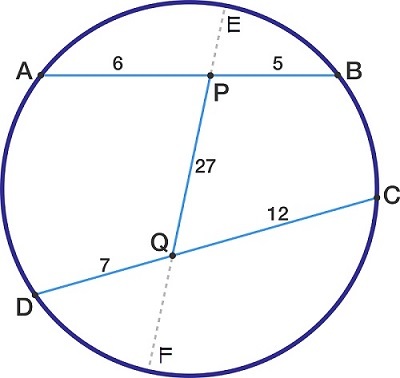Why Does Ptolemy Start With :-P
A B C D is a cyclic quadrilateral with A B = 1 1 and C D = 1 9 . P and Q are points on A B and C D , respectively, such that A P = 6 , D Q = 7 , and P Q = 2 7 . Determine the length of the line segment formed when P Q is extended from both sides until it reaches the circle.
Note : The image is not drawn to scale.
The answer is 31.
This section requires Javascript.
You are seeing this because something didn't load right. We suggest you, (a) try
refreshing the page, (b) enabling javascript if it is disabled on your browser and,
finally, (c)
loading the
non-javascript version of this page
. We're sorry about the hassle.
3 solutions
Ha, I used the same solution, but I cut it short when I realized the answer is probably a positive integer. So 6*5 = 30 = 27a + ab, to which the only solution in the natural numbers is (a, b) = (1, 3). Finally 27 + a + b = 31
@Satvik Golechha FYI, for images of geom diagrams, it is often better to use a thicker line, so that it can be easier to see.
Log in to reply
Thanks. Will keep that in mind next time. BTW A drawing tool on Brilliant would make things much easier... :D
I used coordinate geometry for that ,it was too long but I got the answer
This is a nice transcendence example of Property of similar triangles and theorems on circular angles
I had reached those 2 equations, but how to solve them?
Log in to reply
If you take their difference, you get 2 7 ( b − a ) = 5 4 so b − a = 2 . Substitute that into either equation, and you get a quadratic for a giving a = 1 , − 3 0 .
 By the
power of a point
, we have
By the
power of a point
, we have
P E ( P F ) = P B ( P A ) = 5 ( 6 ) = 3 0
P E ( 2 7 + Q F ) = 3 0
P E = 2 7 + Q F 3 0 ( 1 )
By the power of a point again, we have
Q F ( Q E ) = 7 ( 1 2 ) = 8 4
Q F ( 2 7 + P E ) = 8 4 ( 2 )
Substitute ( 1 ) in ( 2 ) , we have
Q F ( 2 7 + 2 7 + Q F 3 0 ) = 8 4
( Q F ) 2 + 2 5 Q F − 8 4 = 0
By factoring, we have
( Q F + 2 8 ) ( Q F − 3 ) = 0
Q F = − 2 8 or Q F = 3 (reject the negative value)
So, Q F = 3 .
It follows that,
P E = 2 7 + Q F 3 0 = 2 7 + 3 3 0 = 1
Finally,
E F = 2 7 + 3 + 1 = 3 1
What is a power of the point?
If a point is an intersection of two lines that joins 2 points each on the circumference of the circle, such that all four points are on the circumference , or they can become a cyclic quadrilateral. Let’s say a, b , c and d are points on circumference, and line ab and line cd intersect each other in circle and let’s call intersection point p. Theorem power of the point states that ap pb=cp pd. Or line ( from circumference to intersection )*(line from intersection to other end of line in circumference)=other line’s part from circumference to intersection) *(part of the line from intersection to other end of line in circumference).
Why is this problem under "Ptolemy's Theorem"?
The same question I asked myself.
This is a nice problem! Let P Q meet the circle creating the line X P Q Y (where X and Y are the intersections with the circle). Let P X = a and Q Y = b for brevity. Then by intersecting chords, a ( 2 7 + b ) = 6 × 5 b ( 2 7 + a ) = 7 × 1 2 and solving these gives a = 1 , b = 3 . Therefore the answer is 3 1 .